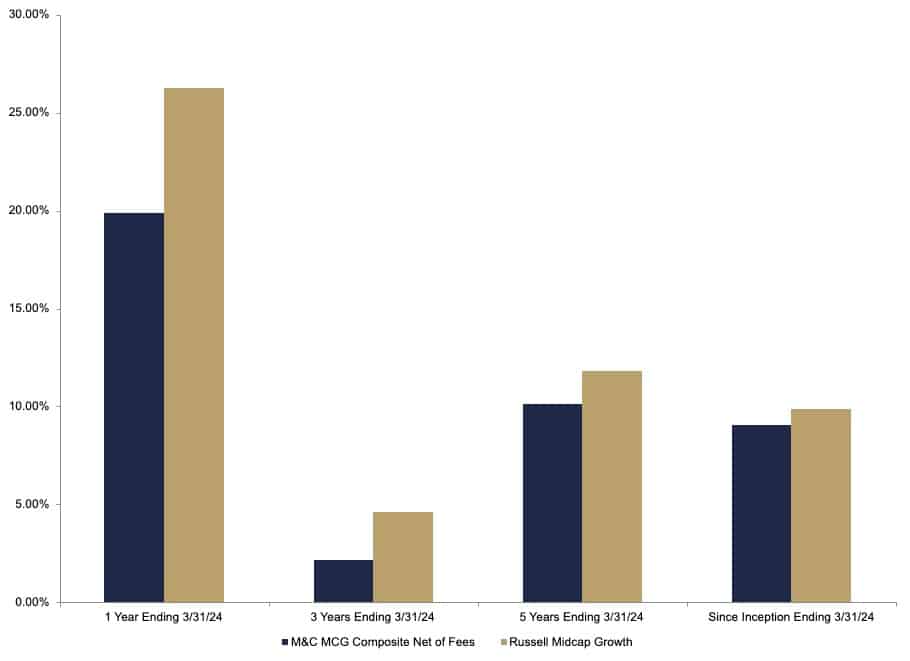Overview
 The Montag & Caldwell Mid Cap Growth strategy extends the Firm’s capabilities into the mid cap asset class while leveraging the strength of the Firm’s resources and its successful, time-tested, fundamentally driven investment process.
The Montag & Caldwell Mid Cap Growth strategy extends the Firm’s capabilities into the mid cap asset class while leveraging the strength of the Firm’s resources and its successful, time-tested, fundamentally driven investment process.
Philosophy
The Mid Cap Growth portfolio is a best ideas portfolio of high-quality mid-cap growth stocks, defined as having a market capitalization at the time of acquisition within the range of the market capitalization of companies constituting the Russell Midcap Growth index, that offer compelling combinations of earnings growth and attractive valuation. Our objective is to identify stocks that are selling at a discount to intrinsic value and exhibit above-median near-term relative earnings strength. We favor companies with leading franchises, proven management teams, strong finances, and attractive long-term secular growth characteristics.
Process
The Mid Cap Growth stock selection process is complemented by a risk-adverse approach that employs both balanced diversification and a strict sell discipline.
Sector Weights
March 31, 2024
Portfolio sector weights are of the Montag & Caldwell Mid Cap Growth Representative Account. Please see the disclosures presentation at the bottom of this page for important information that is pertinent to this chart. Source: FactSet
Vehicles
Separate Accounts
The Mid Cap Growth strategy is offered through separate account mandates which we introduced in April 2007. This product leverages our firm’s investment process and discipline in the mid cap area. The Mid Cap Growth strategy is a logical extension of our large cap strategy and expands our research level to companies with approximately $2 billion in market capitalization. Many of these names are currently being covered for our Large Cap Growth strategy and therefore this work does not compromise the integrity of that strategy in any way.
Risk
Our use of a stock-specific, risk-adjusted discount rate, which is unique, and conservative growth assumptions in our quantitative valuation process have contributed to reducing risk in our portfolios while allowing us to maximize upside potential.
The chart shows the standard deviation of the Montag & Caldwell Mid Cap Growth Composite vs. the Russell Midcap Growth Index. Please see the disclosures presentation at the bottom of this page for important information that is pertinent to this illustration. Data as of December 31, 2023. Source: National Consulting Firm
Standard Deviation

Portfolio Detail
As of March 31, 2024
Portfolio characteristics and top ten equity holdings are of the Montag & Caldwell Mid Cap Growth Representative Account. Please see disclosure presentation at the bottom of this page for important information that is pertinent to these tables.
Characteristics
Source: FactSet
| Number of Holdings | 29 |
| P/E - Next 12 months | 22.38 |
| 5 Yr. Average ROE | 15.46 |
| LT Debt to Capital | 29.47 |
| Est 3-5 Yr EPS Growth | 7.4 |
| Weighted Avg Market Cap | $37,629 MM |
| Median Market Cap | $29,014 MM |
| Return on Invested Capital (ROIC) | 8.5 |
| Active Share | 92.09 |
| 12 Months Turnover | 36% |
Top Ten Holdings
Source: Portfolio Accounting System
Top Ten Holdings are a percentage of Equities only. References to specific portfolio securities are not intended as recommendations of those securities and carry no implications about past or future performance. Information about all recommendations made within the past year is available upon request.
| ICON Plc | 5.2 |
| Primo Water Corporation | 4.7 |
| Copart, Inc. | 4.6 |
| Workday, Inc. Cl A | 4.5 |
| Raymond James Financial, Inc | 4.4 |
| Edwards Lifesciences Corp | 4.4 |
| Veeva Systems Inc. Class A | 4.3 |
| Take-Two Interactive Software, Inc. | 4.2 |
| Wex Inc. | 4.2 |
| Alcon AG | 4.1 |
Disclosures
The Mid Cap Growth Composite used to calculate the standard deviation risk metric reflects all discretionary separately managed accounts eligible for inclusion in the Composite for the periods shown. Calculations based on monthly returns. The Russell Midcap Growth Index is an unmanaged index commonly used as a benchmark to measure mid cap manager performance and characteristics. An investor cannot invest directly in an index. For additional Composite details, please see “Disclosures Presentation” link below.
This information is provided for illustrative purposes only. It should not be considered investment advice or a recommendation to purchase or sell any specific security or invest in a specific strategy nor used as the sole basis for an investment decision. All investments carry a certain amount of risk. There are no guarantees that the strategy will achieve its investment objective, and loss of value on investments is a possibility. Principal risks associated with this strategy include: • Growth Stock Risk – These stocks may be more sensitive to market movements because their prices tend to reflect investors’ future expectations for earnings growth rather than just current profits. • Mid-Capitalization Stock Risk – The stocks of mid-capitalization companies may have greater price volatility, lower trading volume, and less liquidity than the stocks of larger, more established companies. • Sector Risk – To the extent the strategy has substantial holdings within a particular sector, the risks associated with that sector increase. • Foreign Investment Risk – From time to time, the strategy may invest in U.S. registered ADRs and foreign companies listed on U.S. stock exchanges which involve additional risks that may result in greater price volatility. • Liquidity Risk – The strategy may not be able to purchase or dispose of investments at favorable times or prices or may have to sell investments at a loss. • Market Risk—Market prices of investments held by the strategy may fall rapidly or unpredictably due to a variety of factors, including changing economic, political, or market conditions, or other factors including war, natural disasters, or public health issues, or in response to events that affect particular industries or companies.